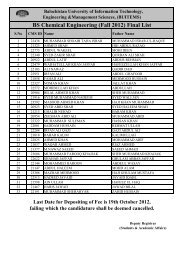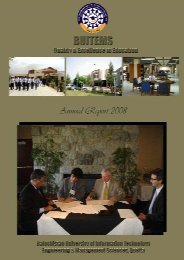BUITEMS
Research Journal - buitems
Research Journal - buitems
- No tags were found...
Create successful ePaper yourself
Turn your PDF publications into a flip-book with our unique Google optimized e-Paper software.
<strong>BUITEMS</strong><br />
Quality & Excellence in Education<br />
Extraction of Active Components of Aloe Vera to Treat Acne/pimple<br />
in Population of Quetta City<br />
Asma Yousafzai * , Saima Saleem, Nusrat Jahan, Fariha Javed, Muhammad Waseem Khan,<br />
Razia Kanwal<br />
Department of Biotechnology and Informatics, Balochistan University of Information<br />
Technology, Engineering & Management Sciences, Quetta<br />
Abstract<br />
Comprehensive study of local aloe vera and its effects on acne/pimple was performed. The work<br />
mainly describes the chemical investigation of aloe vera by traditional methods to check its<br />
efficacy in the treatment of acne. Local aloe specie was gown and solutions of different<br />
concentration were made. Samples of acne were collected from different acne sufferers to identify<br />
the microbe which is major cause of acne infection. Doses of different concentrations of aloe<br />
vera were tested on the acne causing microorganism. In the present work traditional methods<br />
of plant extraction were used to find the relationship between aloe vera and acne treatment.<br />
Doses of different concentrations were calculated and analyzed to treat acne.<br />
Key Words: Aloe vera, Acne, Pimple, Traditional treatment, Medicinal plant<br />
* Corresponding Author’s email: asmakhan@buitms.edu.pk<br />
INTRODUCTION<br />
Aloe barbadensis miller (Aloe vera) belongs<br />
to the Liliaceal family,of wich there are about<br />
360 species. It is a cactus-like plant that<br />
grows readily in hot, dry climates and<br />
currently, because of demand is cultivated in<br />
large quantities (Newall et al., 1996).<br />
Succulent almost sessile perennial herb, has<br />
leaves 30-50 cm long and 10cm broad at the<br />
base, color pea green (when young spotted<br />
with white), bright yellow tubular flowers<br />
25-35 cm in length arranged in a slender<br />
loose spike, stamens frequently project<br />
beyond the perianth. Its thick leaves contain<br />
the water supply for the plant to survive long<br />
periods of drought (Foster, 1999). Due to the<br />
increasing development of antibiotic<br />
resistance, the emphasis of the present study<br />
is being given on the use of Aloe vera as a<br />
natural remedy for the inhibition of various<br />
infections and to identify the different<br />
compounds. (Agarry et al., 2005)<br />
Among these the most popular is Aloe<br />
Barbadensis Miller which has most<br />
therapeutic value and referred to as ‘True<br />
Aloe’. After all the research, it has been<br />
accepted that Aloe Barbadensis Miller is the<br />
best, as it is the most consistent of all<br />
varieties. Aloe Vera is generally propagated<br />
by root suckers by carefully digging out<br />
without damaging the parent plant and<br />
planting it in the main field. It can also be<br />
propagated through rhizome cuttings by<br />
digging out the rhizomes after the harvest of<br />
the crop and making them into 5-6 cm length<br />
cuttings with a minimum of 2-3 nodes on<br />
them. Then they are rooted in specially<br />
prepared sand beds or containers. (Boudreau<br />
and Beland, 2006; Oala et al., 2007).<br />
Its thick leaves contain the water supply for<br />
the plant to survive long periods of drought.<br />
These leaves have a high capacity of<br />
retaining the water. When a leaf is cut, an<br />
orange yellow sap drips from the open end<br />
which has a very strong laxative effect. When<br />
the green skin of a leaf is removed a clear<br />
mucilaginous substance appears that contain<br />
fibers, water and the ingredients to retain the<br />
water in the leaf. These ingredients give this<br />
"gel" its special qualities as they are known<br />
now for many centuries. Among the uses for<br />
this gel is acceleration of wound healing, use<br />
65
















